

Spread the rail with your thumbs, but only enough to fit the rail over the piston.
Release the rail into the bottom piston ring groove.
NOTE
The oil ring rails have no “top” or “bottom”.
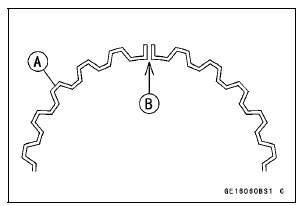
NOTE
Do not mix up the top and second ring.
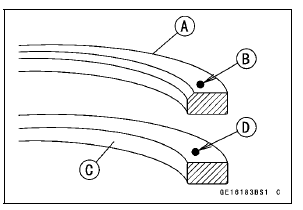
NOTE
If a new piston is used, use new piston rings.
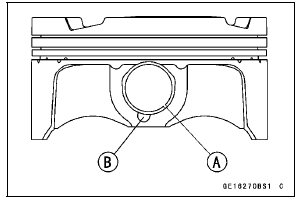
When installing the piston pin snap ring, compress it only enough to install it and no more.
NOTICE
Do not reuse snap rings, as removal weakens and deforms them. They could fall out and score the cylinder wall.
 40° of angle from the
40° of angle from the
Top Ring [A]
Second Ring [B]
Oil Ring Steel Rails [C]
Oil Ring Expander [D]
Hollow [E]
30  40° [F]
40° [F]
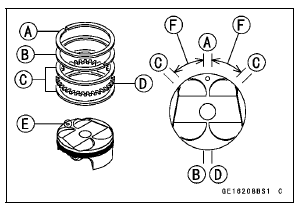
Special Tools - Piston Ring Compressor Grip: 57001-1095
Piston Ring Compressor Belt,  67
67

 79:
79:
57001-1097
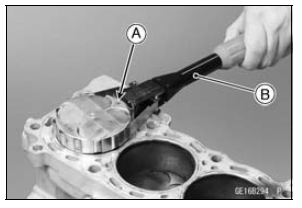
 Piston Removal
Piston Removal Cylinder (Upper Crankcase) Wear Inspection
Cylinder (Upper Crankcase) Wear InspectionS-KTRC Warning Indicator Light
The yellow warning indicator light in
the meter unit functions as the S-KTRC
warning indicator light. The yellow
warning indicator light and all S-KTRC
mode indicators blink whenever there
is a malfunction in the S-KTRC system.
At this time, the S-KTRC system does
not function.
If the ye ...
Cable Removal
Remove:
Air Cleaner Housing (see Air Cleaner Housing Removal
in the Fuel System (DFI) chapter)
Right Lower Fairing (see Lower Fairing Removal in the
Frame chapter)
Loosen the nuts [A], and slide the lower end of the clutch
cable to give the cable plenty of play.
Screw in the ...
Leather, Vinyl, and Rubber
If your motorcycle has leather accessories,
special care must be taken.
Use a leather cleaner/treatment to
clean and care for leather accessories.
Washing leather parts with detergent
and water will damage them, shortening
their life.
Vinyl parts should be washed with the
rest of themo ...